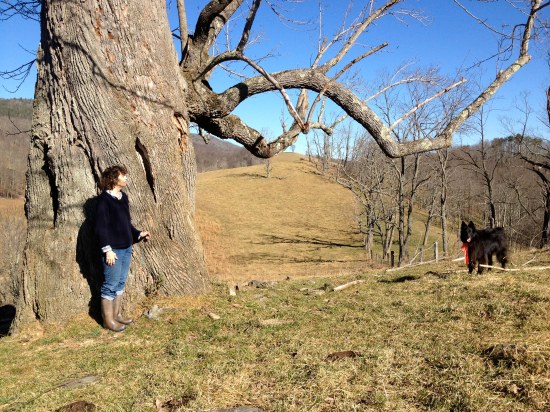“I found a ball of string. Let’s go to Stark’s Ridge and measure the cucumber tree.”
I looked at the ball of string my husband held in his hand. The string looked frail, dusty, and old, like so many of the things in my parents’ abandoned farmhouse. A ball of string, however, is always useful.
“And I found this metal tape measure,” he adds. It is the hard, roll-out kind that’s too stiff for wrapping around a tree.
Violent windstorms in July 2012 had toppled trees out of the Earth in Highland County, Virginia, like toothpicks. The other old giant cucumber tree had lost its top, and a young giant had fallen over, its root bundle exposed to the air. Only a few cucumber trees remain on Stark’s Ridge, an elevated mountain crest full of limestone outcroppings.
“Sure,” I said. My husband knows trees. He grows them from skinny little whips, He prunes them, watching their identifying features develop– leaves, flowers, buds, and bark. I think he has forgotten that I measured the tree a few summers ago and reported my measurement to him. However, I am willing to watch his methodology because I know that repeated measurements yield better data.
Getting to the top of Stark’s Ridge requires exertion, if not downright huffing and puffing. The top of the ridge, thankfully, is long, narrow, and pretty flat, interrupted only by the occasional beautiful rock pile and locust tree. The pair of old giants stands on a gentle promontory, or undulation, of the ridge. From their trunks, one has a grand view of Vinegar Hollow and folds and folds of blue hills stretching for miles to the south and east. The view to the west is the solid flank of Back Creek Mountain.
In recent years I have approached the old cucumber giants with the acknowledgement that they were dying, losing long limbs faster than they were growing new leaves. The Latin, or scientific name, for the cucumber tree is Magnolia acuminata L. (L. stands for Linnaeus, the Swedish botanist who invented binomial classification). As an aging personage, akin to an old tree myself, I am interested in wrinkled, hardened beings. In order to understand the cucumber tree better, I consult my mother’s copy of Charles Sprague Sargent’s Manual of the Trees of North America in Two Volumes. The back book jacket advertises the fact that Charles Sprague Sargent is “the greatest dendrologist America has ever produced.” It further asserts that these two volumes allow the tree lover to identify any native tree in the United States through keys. Do not believe that such an assertion is easily followed.
The keys for identification of the mountain magnolia that C. S. Sargent presents are based on flower color: the cucumber tree keys out first based on its flower color. It has greenish petals vs. the canary yellow petals/white petals/pale yellow or creamy white petals of other native magnolias. Of course, there are no magnolia flowers in November. Keys are beguiling because they make identification look so straightforward, but horribly frustrating to those observers who are out of season with the keys’ chief identifying characteristics. The cucumber tree is named for its aromatic gherkin-like fruits, from which, when ripe, bright red seeds dangle on white elastic threads.
Measuring begins. I tie Belle the dog to a branch of the tree that has fallen on the ground to keep her out of the way. Trees are usually measured at breast height (dbh, diameter at breast height). My husband ties one end of the frail string to a piece of hard bark that protrudes from the cucumber tree at his breast height. He continues wrapping it around the stupendous girth of the tree adjusting its placement for dbh at each step, because there is a two-foot slope difference from one side of the tree to the other. Then he calls for my assistance.
“Now we need to measure the string.”
We searched for somewhat level ground so that he could stretch his string forth in a straight line. He tapped a little stick in the ground to secure the end of the string. Then he stretched the metallic tape measure alongside the string. The tape ended about two-thirds the length of the string—15 feet. A readjustment of the tape measure along the string yielded another 7 feet! So—the giant measured 22 feet in circumference. My husband, through a quick mental calculation, translated that to 7-foot diameter. Charles Sprague Sargent allows 3-4 feet as the usual diameter for mature cucumber trees in North America.
My measurement, taken two years ago with my husband’s orange plastic nurseryman’s tape, was 21-foot circumference. (I simply wrapped the tree with the bright orange tape, broke the tape at the full circle point, put the length in my pocket, and brought it back to Ithaca to measure with a yardstick. I don’t think I corrected my dbh for slope.) I am happy that this tree came in at 22 feet around. I was sure that it was a tree for the books. A champion. Sargent describes the ideal shape of the tree as “pyramidal.” However, because cucumber trees are weak wooded, such a tree on a mountain ridge has suffered many weather-related assaults that have twisted its growth patterns, and led to loss of limbs and subsequent clumps of dense younger growth in remaining limbs. It reminds me of the Little Prince’s baobab tree in Saint-Exupery’s book of the same name.
I am happy that we have spent this time circling the tree, honoring its girth and its presence in this small hollow. There are other cucumber tree lovers out there. Please see this thread posted on the Native Tree Society by Will Blozan (http://www.nativetreesociety.org/fieldtrips/west_virginia/cucumbertree/speaking_of_cucumbertree.htm). A scroll through the thread offers some wonderful photographs (particularly one of a tree pruner’s shadow joined into the shadow of the tree) and information on the tree and its medicinal properties.




